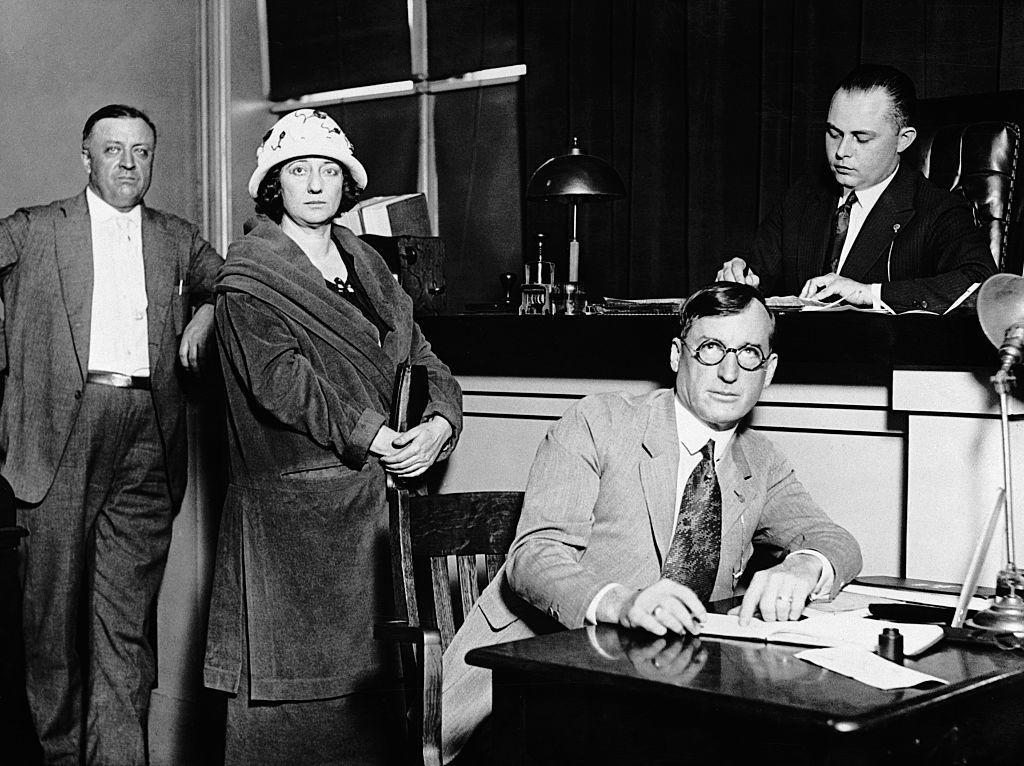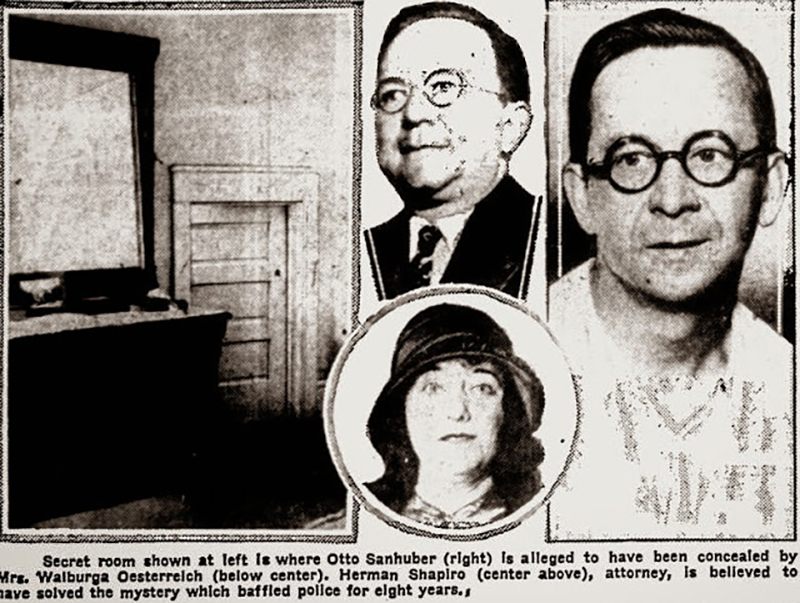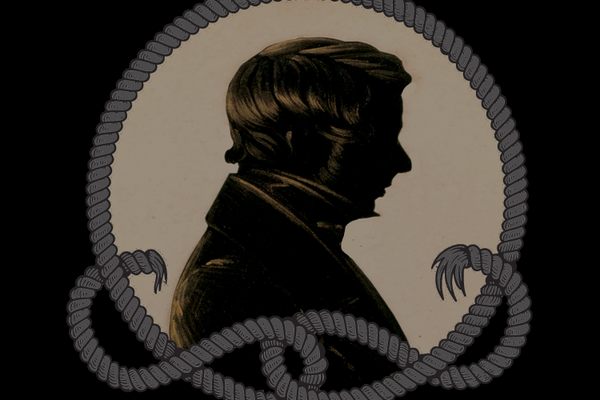The Married Woman Who Kept Her Lover in the Attic
Dolly Oesterreich, her “Bat Man,” and one of the strangest sex scandals ever.

Walburga ‘Dolly’ Oesterreich being arraigned in court on the alleged charges of murdering her husband. Left to right: Detective Cline, Mrs. Oesterreich, Judge Channing Follette, and a court reporter. (Photo: Bettmann/ Getty Images)
In April 1930, the Los Angeles Times began publishing what would end up being months’ worth of eye-popping details from an exceedingly strange court case. It involved a “comely” woman named Dolly, her murdered husband, and her lover, a man known as the “garret ghost” who, at Dolly’s behest, lived a “bat-like life in hidden rooms.”
The story of how the three were intertwined is worthy of the era’s most lurid pulp novels.
Born in 1880, Walburga “Dolly” Korschel was a German immigrant who grew up on a poor Midwestern farm. In her early 20s she married Fred Oesterreich, the wealthy owner of a successful apron factory. The couple settled in Milwaukee but marital bliss was elusive—Fred drank too much and Dolly was sexually unsatisfied. “Her eyes and her appetites would bring a long line of men into her life—and send one to his death,” wrote the LA Times.
One uncharacteristically hot autumn day in 1913, Dolly asked Fred to send one of the factory’s repairmen to the house to fix her sewing machine. When 17-year-old Otto Sanhuber knocked on the Oesterreichs’ ornate double entry door, Dolly, then 33, answered wearing stockings, a silk robe, and nothing else. In the master bedroom the dusty old Singer machine remained untouched; the same could not be said for Mrs. Oesterreich. Their tryst that day marked the beginning of a multi-decade sexual relationship.
In the early days of their affair, Dolly and Sanhuber met in hotels. Soon they decided to throw caution to the wind and pursue their carnal pleasures from the comfort of the Oesterreichs’ marital bed. But the heartland in 1913 was the epicenter of a moral conservatism that characterized pre-sexual revolution America. The neighbors grew suspicious of the frequent visits paid by a man Dolly referred to as her “vagabond half-brother.”
Dolly had a solution: Sanhuber would quit his job and move into the Oesterreichs’ attic. Fred never went up there and the lovers could continue their tryst safely out of sight from prying eyes. The only caveat was that young Sanhuber would have to abandon all human interaction save for the tantric time he spent each day with Mrs. Oesterreich. Sanhuber didn’t mind. He had no family to speak of and, as the LA Times reported in 1930, he said he grew to love Dolly “as a boy loves his mother.”

Dolly Oesterreich, c. 1930. (Photo: Public Domain)
The attic, furnished with only a cot and a desk, became a blank canvas upon which the teenager projected his inner dream world. At night he devoured the piles of nautical adventure books that Dolly brought him each week from the library. Like the marooned castaways in his favorite novels, Sanhuber staved off madness by occupying his thoughts with a singular goal: his dream-turned-obsession was to write for the pulps.
Pulp fiction magazines were the descendants of the 19th-century “penny dreadful.” For 10 cents readers could satisfy their prurient curiosities with tales of sex, murder, addiction, and madness. Pulps like Argosy (1882-1978) were famous for cover art featuring half-dressed damsels in distress awaiting a rescue hero. Perhaps when Dolly answered the door in her flimsy silk robe, Sanhuber saw an opportunity to live his art.
By 1918 Sanhuber had been living in the Oesterreichs’ attic for five years undetected, having regular sex with Dolly, and even publishing some of his stories under a pen name. Meanwhile, Fred began questioning his sanity: He heard inexplicable noises coming from the attic, his cigars kept going missing, and he could swear that strange shadows passed outside his bedroom door some nights. He decided to move to Los Angeles that year, not knowing that the phantom haunting his Milwaukee mansion would follow him out West.
Dolly agreed to the move on the condition that the new house have an attic. She sent Sanhuber ahead and by the time the Oesterreichs arrived, the now 22-year-old was already settled in his new home.
In Los Angeles the Oesterreichs’ marriage began to deteriorate. Fred drank even more than he did in Milwaukee and arguments between the couple became violent. On August 22, 1922 a particularly brutal fight broke out and Sanhuber, fearing for Dolly’s life, ran downstairs brandishing Fred’s two .25 caliber rifles. He fired three rounds straight into his rival’s chest, killing him instantly.
The lovers decided to rig the scene to make it look like a home invasion: Sanhuber took Fred’s diamond watch and locked Dolly in the closet. Once Sanhuber had safely snuck back up to the attic Dolly began screaming until one of the neighbors called the cops. The police had no reason to doubt Dolly’s story—after all she couldn’t have locked herself in the closet. So the merry widow inherited her husband’s millions and bought herself a new house. With a spacious attic.
Even though there was no apparent need to continue hiding Sanhuber in the attic, after a decade the lovers’ relationship had shifted into one based on dominance and submission. Years later Sanhuber would tell a jury that he was Dolly’s “sex slave,” imprisoned by his love for her.
Dolly started dating her lawyer, Herman Shapiro, at which point she began making a series of incriminating mistakes. Her first was to give Herman the diamond watch that had supposedly been stolen during the “robbery.” Herman recognized the watch as Frank’s but Dolly explained sweetly that she had found it under a seat cushion and saw no need to tell the police. According to the LA Times, which reported on the murder in 1923, that evening Dolly asked a third lover, Roy Klumb, to dispose of the murder weapons in the La Brea tar pits.
In 1923 the police found out about Frank’s watch and Klumb, following a volatile breakup with Dolly, confessed to disposing of the guns. They arrested Dolly but still unable to explain how she had locked herself in the closet, were forced to drop the charges and release her from custody. During the hearings she made another damning mistake when she asked Shapiro to bring food to her attic-dwelling “vagabond half-brother.” Sanhuber was happy to see Herman. He hadn’t spoken to another man in over a decade and regaled the lawyer with tales of his sexual exploits. Shapiro kicked Sanhuber out of the attic that very day and the terrified young man fled to Canada.
Herman and Dolly’s relationship ended on a sour note in 1930. Feeling spiteful, he told the police about Sanhuber who coincidentally, had just moved back to Los Angeles. By the time the ex-lovers were arrested the papers had gotten wind of the sordid tale and shutterbugs followed Dolly and Sanhuber everywhere. But the trial outcome was not as eventful as the public would have hoped: though the jury found Sanhuber guilty of manslaughter on July 1, the statute of limitations for such an offense was seven years. Eight years had passed since Frank’s death. Sanhuber’s charges was dropped.

A newspaper clipping from the time. (Photo: Public Domain)
Dolly was acquitted, after which she found a new lover. They stayed together for 30 years, eventually marrying. She died a free woman in 1961.
Sanhuber left Los Angeles and disappeared. During the media frenzy that surrounded the trial he became known as “the Bat Man of Los Angeles” due to his formerly bat-cave-like living circumstances. (Superhero comics, the descendants of pulp fiction, did not exist in 1930 and neither did the gallantry now associated with the name “Batman.”)
Thanks to the tabloid treatment Sanhuber received during the trial, the public saw him not as the tragic romantic he envisioned himself to be but as an immoral sexual deviant with a freaky penchant for attic living. The deputy district attorney called him a “perjurer of his own soul.” Sanhuber may have been freed from the judgment of the law, but he would have to contend with the judgment of newspaper readers transfixed by the salacious story.
“Nothing in fiction is more dramatic than the story of the sudden quarrel in the hallway, the popping out of an armed jack-in-the-box, the struggle, the slaying, the locking of Mrs. Oesterreich in a closet with the key outside and the mysterious disappearance of the slayer back into his cubbyhole,” said the LA Times in 1930. “Yes, it must be admitted fiction has been outdone again.”

















Follow us on Twitter to get the latest on the world's hidden wonders.
Like us on Facebook to get the latest on the world's hidden wonders.
Follow us on Twitter Like us on Facebook